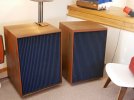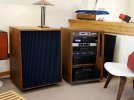Even today speakers are largely a personal choice, but back then I would submit that loudspeakers had even more character, aka: were not transparent. Therefore the speakers that any one individual might have picked over a pair of L100s would have been dependent on what the listener was looking for.
The JBL 4310, which was the first version of the monitor that was to become the L100 was designed with a very forward midrange to mimic the sound of the Altec 604E monitors that were the de facto industry standard in the US. The goal was not the most accurate speaker, or the speaker with the most extended range, and certainly the polar response was not really considered. This gave the L100 an unusual and characteristic sound.
In no particular order here is a list of speakers that were available in 1972 that were arguably better in one or more ways than L100s. Some cost more than L100s and others cost less.
AR3a
ESS AMT1
Tannoy Monitor Gold
BBC designed LS3/5a
KLH9
Quad ESL 57
From my personal experience, at the time, I'd add the L200s to that list.

(I liked the Quads (bass shy), the KLHs were a bit 'dull' (Advent like, as the AR3a's), never heard the ESS's or Tannoys)
I spent months and
months comparing JBLs and other brands, and from other stores, with the help from a pretty advanced hifi shop (all about measurements - sound familiar?) who had an EE AES Prof as a 'consultant'.
I had started (college) with a brand new set of Advents, and pretty quickly replaced them with JBL Decades, but soon found them wanting.
Then the JBL L200 entered my consciousness, and was largely amazed at them - aside from boomy bass.
Also, the dealership - also a pro sound house - told me about the (then new) 077 supertweeter and xover that would be an easy upgrade, and the JBL factory rep specifically recommended it. (They put me on speakerphone with the JBL engineer in California to discuss

.
I never cared (really, at all) for the L100, so was looking for more 'presence' and better power handling and dynamics, so the L200s, with their elegant mid- century modern,
very well crafted (as I found out later when I tried to clone one!) walnut cabinetry were only a 'slight' increase in cost

I'd just finished paying off my first brand new car (Datsun 510, $2800) so simply had the bank extend that loan to cover the speakers ($670 I think...each, maybe? I have the receipt somewhere still).
As soon as that was paid off, I bought the 3-way upgrade kit and had them install it, which was a significant improvement in MF/HF range and tonality.
About then, the L300 was announced, and tho it annoyed me a bit, I didn't care as much for the cabinet design, and argued that the 3 way L200 was not much different (bass was significantly better - but still far from perfect - in the L300, but it was also a lot more expensive, and I wasn't about to trade them in at a huge loss for such a minor improvements.)
The fact is, there just weren't a lot of really good choices for great bookshelf speakers, back then (well, many , of course for typical college LOUD rock n roll fans): Klipsch and a few others made larger, and roughly comparable, models to JBL offerings, and a few others (that motion sensor controlled philips speaker really blew me away - but was very expensive - otherwise would have been a fine choice).
So, 'the great 70s' bookshelf speakers, were just not that great, at all, in any way - in my opinion.
I spent 30 years trying to 'fix' the boomy bass drivers in those L200s, but I have to say they
are durable - I bought some replacements at one point, and both sets sill work!
But the true magic of the L200s capability didn't really come together until the 4367's 2216ND-1 became available.
(The L200s L15Bs were the original 2216s in the Pro line.)
I took a risk, and
boy did that turn out well - call them 4367/L300 hybrids or whatever, but the 'just drop in' combo works like crazy good.
I disconected the (horrible) original LX-16 two way crossover, and simply bi-amped them with the (L300) JBL xover managing the MF/HF, and the woofer taken care of by a Venu 360 implementing mostly the 2216ND M2 settings as described elsewhere.
Months of REW tests got me to the conclusion, that, kind of 'as expected' (hoped) the L200 cabinet dimensions were within a few CCs of the 4367, as were the (dual) ports, and pretty quickly was getting 20hz-20khz +/- 3db flat response out of them.
That was, what, nearly 10 years ago now, and I haven't even been tempted to make any further changes (well, a better electronic xover is a 'may never know' temptation, esp since the main DAC is the Okto8.)
L200s for some reason had a terrible 'reputation' even at the time -not sure why so many haters came out of the closets - but they sure sold like crazy in the US, with some going into clubs, etc, but the things still show up for sale in somewhat decent condition - not something you see from other manufactures of 50 yr old speakers much.
As for cabinetry, I suppose additional bracing might improve things a bit, but really not so much it matters to me (I did consider adding more as well as may other 'tricks' offered up).
Fact is, the quality of JBLs cabinetry shop was second to none - wonder how far JBL was from the Charles/Ray Eames shops at the time??
When I (stupidly) thought I'd 'clone' one of those cabinets to use as 19" rack, it took me MONTHS to figure out exactly how they managed all those nearly invisible trim and other angles on it - and much scrap lumber!! It worked in the end, but wasn't really 'worth' the effort comapred to a well made commercial rack (well, it
is a nice disguise).
The darned things have wowed me (esp since the ND1 upgrades) for decades, and still take my breath away.
Yes, I have newer speakers, IN8s, LS305s, etc...but as 'fine' as those are (the 305s and similar are remarkable for the price, but NOT theatre good), the older JBLS just have dynamics still hard to match.
Weirdly the 'best' "new" speaker I've added 'recently' is a pair of the plastic cabinet L25 Primas - they sound amazing, esp for TV use now. (I volume match compared all three, and the Primas were my favorite - mostly for wider and more even dispersion, ideal for TV use).
Strange, bc I never cared much for the L26 Decades, and these are supposed to be the same drivers - maybe something to the 'special acoustic' plastics they were made from.
Gah. Enough gab.
Loud n Clear, Indeed!!


